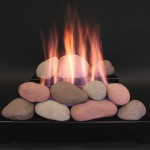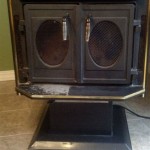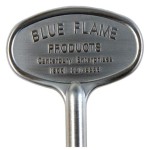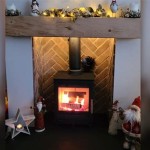How to Decorate Fireplace Mantels: A Comprehensive Guide
Fireplace mantels serve as focal points in many living spaces, offering a unique stage for showcasing personal style and seasonal décor. Effective mantel decoration involves a careful balance of aesthetics, functionality, and proportions. This article explores various approaches to fireplace mantel decoration, providing guidelines and insights to create visually appealing and harmonious displays.
Understanding Mantel Architecture and Dimensions
Prior to commencing any decorating project, it is crucial to thoroughly assess the architectural style and dimensions of the fireplace mantel. Mantels vary significantly in design, ranging from minimalist, modern structures to ornate, traditional pieces. The mantel's depth, length, and height dictate the size and scale of decorative elements that can be effectively incorporated. For instance, a shallow mantel may only accommodate narrow objects, while a wider mantel provides greater flexibility for arranging larger items or creating layered displays.
Consider the overall style of the room. A contemporary room benefits from a sleek, uncluttered mantel, while a more traditional space might call for richer, more elaborate designs. Analyzing the existing architectural features, such as wall color, flooring, and furniture style, helps determine a cohesive design approach for the mantel.
Accurate measurements are essential. Note the mantel's length, depth, and the distance between the mantel and the ceiling. These measurements are pivotal in determining the appropriate size and number of decorative objects. Overcrowding a small mantel creates a cluttered appearance, while under-decorating a large mantel can result in a sparse and underwhelming effect.
Examine the fireplace itself. Is it a traditional wood-burning fireplace, a gas fireplace with decorative logs, or an electric fireplace with a simulated flame? The type of fireplace influences the overall design aesthetic and may necessitate specific safety considerations when selecting decorative elements. For instance, flammable materials should be kept a safe distance from a functioning wood-burning fireplace.
Key Decorating Principles: Balance, Symmetry, and Scale
Successful mantel decoration hinges on the application of fundamental design principles, namely balance, symmetry, and scale. These principles guide the arrangement of objects, ensuring a visually pleasing and harmonious composition.
Balance refers to the distribution of visual weight on either side of the mantel's central point. Symmetry involves mirroring the arrangement of objects on both sides, creating a formal and structured look. Asymmetry, conversely, employs a less structured approach, using objects of varying sizes and shapes to achieve a balanced, yet informal, aesthetic. Choosing between symmetry and asymmetry depends on the desired mood and the overall style of the room.
Symmetrical arrangements are often associated with traditional and formal settings. A classic symmetrical mantel might feature a large mirror or artwork centered above the fireplace, flanked by identical candlesticks, vases, or lamps on either side. The key to successful symmetry is precise placement and consistent visual weight on both sides.
Asymmetrical arrangements offer a more relaxed and modern feel. Achieved by strategically placing objects of different heights, shapes, and textures to create a balanced composition. For example, a tall vase on one side may be counterbalanced by a grouping of smaller objects on the other. The goal is to achieve visual equilibrium without strict mirroring.
Scale refers to the size and proportion of decorative objects relative to the mantel and the surrounding space. Objects that are too large overwhelm the mantel, while objects that are too small become lost and insignificant. Selecting objects that are appropriately scaled for the mantel creates a sense of harmony and visual comfort.
When choosing artwork, consider the size and shape of the mantel and the surrounding wall. A large piece of art can serve as a focal point, while smaller pieces can be grouped together to create a gallery-style display. Ensure the artwork is hung at a height that is comfortable to view from a seated position.
Scale also applies to the depth of objects placed on the mantel. Avoid placing objects that are so deep they protrude excessively, creating a cluttered or unbalanced look. Consider the visual weight of objects as well. A dark, heavy object visually occupies more space than a light, delicate object of the same size.
Incorporating Diverse Decorative Elements
A well-decorated mantel incorporates a variety of decorative elements to create visual interest and depth. These elements can include artwork, mirrors, candles, plants, vases, books, and personal objects. The key to successful incorporation is to select elements that complement each other and reflect the homeowner’s personal style.
Artwork serves as a central focal point, drawing the eye and establishing the overall tone. Paintings, prints, photographs, and sculptures can all be effectively used to decorate a mantel. Consider the subject matter, color palette, and style of the artwork in relation to the room's decor. Abstract art can add a modern touch, while landscapes or portraits can evoke a more traditional feel.
Mirrors are versatile decorative elements that add light and depth to a room. A mirror placed above the mantel reflects light, making the space feel brighter and more open. Consider the shape and frame of the mirror in relation to the mantel's style. A rectangular mirror complements a modern mantel, while an ornate, gilded mirror suits a traditional setting.
Candles introduce warmth and ambiance, creating a cozy and inviting atmosphere. Use candlesticks of varying heights to create visual interest. Scented candles can add a pleasant aroma to the room. Consider using LED candles for a safer and more convenient option, particularly in homes with children or pets.
Plants bring life and freshness to a mantel display. Greenery adds a natural element and can soften the overall look. Choose plants that are appropriate for the light conditions in the room. Low-maintenance options include succulents, air plants, and snake plants. Consider the size and shape of the plant in relation to the mantel's dimensions. Trailing plants can cascade down the sides of the mantel, adding a touch of elegance.
Vases add height and visual interest to a mantel display. Fill vases with fresh flowers, dried arrangements, or decorative branches. Choose vases that complement the mantel's style and the overall color palette of the room. Consider the shape and size of the vase in relation to the other decorative elements.
Books add a touch of intellectual sophistication to a mantel display. Stack books horizontally or vertically to create varying heights and textures. Use books with interesting covers or spines to add visual interest. Consider arranging books by color or subject matter to create a cohesive look.
Personal objects, such as family photos, travel souvenirs, and collectibles, add a personal touch to a mantel display. These objects reflect the homeowner’s interests and create a sense of character and individuality. Arrange personal objects thoughtfully, considering their size, shape, and color. Avoid overcrowding the mantel with too many personal objects.
Seasonal decorations can be incorporated to reflect holidays and special occasions. Change the mantel display seasonally to create a festive and welcoming atmosphere. For example, pumpkins and gourds can be used in the fall, while candles and garlands can be used during the winter holidays.
When incorporating multiple decorative elements, vary the heights, textures, and shapes to create visual interest. Layer objects in front of each other to create depth and dimension. Use risers or small platforms to elevate certain objects and create varying heights. Varying the textures is also very important. Try to place a glass or metallic item near something natural like wood or stone.
Remember to maintain a sense of balance and harmony in the overall composition. Avoid overcrowding the mantel with too many objects. Edit the display periodically to keep it fresh and visually appealing. Over time, tastes change so do not be afraid to rework your mantel.
Regular cleaning of the mantel helps maintain its appearance and prevents dust from accumulating on decorative objects. Use a soft cloth or duster to clean the mantel and the objects on it. Avoid using harsh chemicals or abrasive cleaners, as these can damage the finish.

How To Decorate A Mantel Like Pro Easy Styling Tips From Tidbits Twine Home Decor Fireplace Mantle Living Room

10 Fireplace Mantel Decorating Ideas Full Service Chimney

My Fall Mantel Decor With Joann Bless This Nest

Fall Decor Design Ideas Fireplace Mantel Greenhouse Studio
:max_bytes(150000):strip_icc()/create-a-cozy-fall-fireplace-6a890e0a75a94779be2e6d4ef4784f93.jpg?strip=all)
43 Cozy Ideas For Fireplace Mantels

Mantel Decorating Tips And Ideas Jaymee Srp

Mantel Decorating Ideas For Every Month Of The Year Modern Glam

36 Fireplace Decor Ideas Modern Mantel

Mantel Decorating With A Tv 10 Ideas And Tips Nina Hendrick

30 Top Fireplace Mantel Decor Ideas For Every Interior Displate Blog








